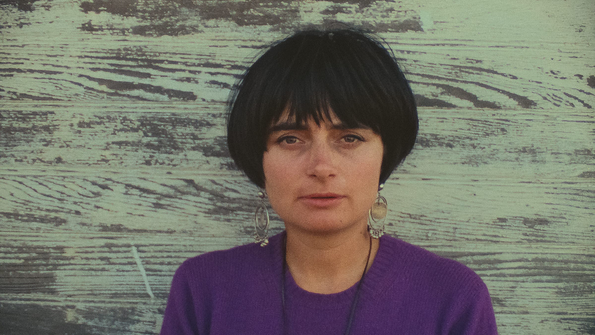Agnès Varda was more a photographer and invested in photographic storytelling in her fictions and non-fictions, such as the murals in Faces Places (Visages Villages, 2017). Experimental photographic narration and her artwork-like uses of the internet therefore is not a coincidence. In her internet accounts, she posed with her fans, while her Instagram account looks like an experimental work, an exhibition, open to the public and unfinished. In her first photograph, she is holding a necklace with a cat figure in her hand.
From her films, behind the scenes, festivals-hipster continued with photos from protests and exhibitions profiles of the times. She manages to sit on the chair with the name of her cat Nini, who suggests watching her last film Varda par Agnès (Varda by Agnès, 2019). Varda's philosophizing of the use of the photography of the word cinécriture coincided with the influence of Jacques Derrida the écriture féminine (feminine writing) for feminist thought in Hélène Cixous’ deconstructive philosophy of writing, especially through the influence of dreamy afterwardsness (nachträglichkeit) in writing in The Laugh of Medusa / Le Rire de la Meduse (1976) and Dream I Tell You / Rêve Je Te Dis (2003).
Deconstructive feminism and Varda's idea of the photographic presence of the absent follow similar philosophical paths. In Postcard, Derrida started with a card with a drawing of Socrates and looked at dozens, even hundreds of images of the carte (card) and collected them in the book as traces of the cards: the richness shown by the derivatives of a word. When a card leaves the sender and to a definite address, time passes and the sender’s past tense becomes the present for the address. For Derrida, accepting the present is a responsibility. Varda, on the other hand, both presents the greeting cards and she accepts the presents and sends a present herself to her characters and to her audience in two years’ time.
Varda carries the deconstructive thought, of which Derrida and Cixous were pioneers, to the field of cinema and the photographic image with her art, which she considers the strategy of 'filmer en femme' (feminine filming) in the context of language and visages from the sender to the addressed without a definite address. For Derrida, time does not belong to anyone. In Varda, time opens up the allegorical territories for the things that bridge the gap of the voided time.
Critics view Agnès Varda like a Greek “goddess”, though she was more a photographer and invested in photographic storytelling in her fictions and non-fictions. Even when she is not even slightly interested in identity politics than feminism and male-female tensions, Greek references are unavoidable in her films and her father was indeed of Anatolian Greek origin, and she also had quite a number of references to the Greek legacies in Turkey. Faces Places (Visages Villages, 2017), for example, is a film of these sexual differences without intermediates.
Varda was suffering from visual-loss, the scene of the eye of a fish in the market is followed by Varda’s eye in her doctor’s office. In a way, her eye is replaced with JR’s sunglasses. JR takes photographs for Varda and of Varda, her eyes and toes, then the two train to Switzerland to meet Jean-Luc Godard for the film. Varda's philosophy was evidently influenced by Godard. In the film, Varda would like to replace the young JR with the old Godard, two French talents in glasses. JR refuses to take off his glasses in the film, and Varda reacts by comparing him with the young Godard who refused to take off his glasses except the film-within-a-film in Cléo from 5 to 7 where Godard and Anna Karina act.
She films her friendship with Godard, Jacques Demy and Karina. Then, Varda and JR re-shoot the famous running scene in the Louvre Museum from Godard's Bande à Part (Band of Outsiders, 1958) in a wheelchair. The film ends in Switzerland, where the two go to meet with Godard, who does not show up for the appointment.
Varda goes to his house and rings Godard's doorbell as if she were doing an adaptation of "Ring My Bell", but he does not answer the door. We understand that he has prepared his role in Varda’s documentary from a note he left on the door for her about Varda's late husband while she cries. At the same time, she’s bearing a deconstructive reflex with the new Godard, the presence of the spirit of the old new-wave Godard. Obviously, Varda and Godard were from different planets in their handling of time.
Godard's is a restless soul, while Varda's is a persistent and constant one that has reached maturity. In Godard's films, the past is a burden. In Varda's films, it is an affluence. Varda calls him a "dirty rat" and leaves a tender note on the door with her tears. Afterwards, she and JR sit on a bench on the shore of Lake Genoa, very close to Godard's house. This final moment of look is not of a loss, despite Varda's ability to see and interpret the world around becoming increasingly difficult. Varda’s loss of her eyesight in the blurry scenes, JR’s sunglasses, old and new friendships, and Godard’s ghost on the way to an assisted suicide. Freudian death.
The “tamed” is the written that resists any representation and the “mad” is the unwritten that deifies the symptom. It is crucial to arrive at an equilibrium for the letter in these uncharted territories, Switzerland and so forth.
